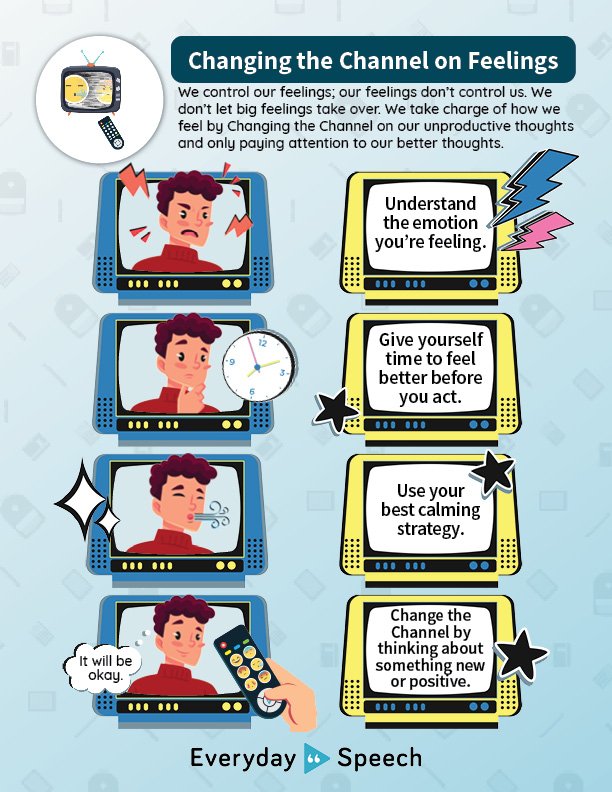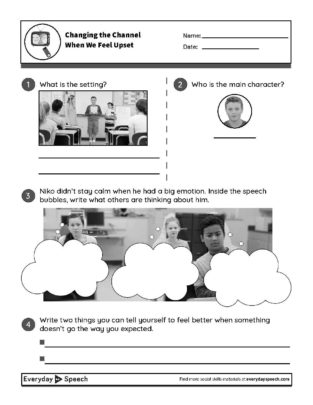Try the no-prep way to teach Changing the Channel on Feelings
Take the prepwork out of teaching essential social-emotional skills with Everyday Speech! Subscribe to access step-by-step curriculum and over 1,000 videos, games, and more.
Preview an SEL skills lesson: Changing the Channel on Feelings

[INTRODUCTION – animated scene in classroom]
Narrator: Strong emotions like anger, frustration, or sadness can fill our whole brain and make us choose poor decisions.
Teacher: (to Boy) You’re going to work with Kylie and Stacey.
Boy: (visibly upset, internal thought) I can’t work with them!
Narrator: All emotions can be controlled, even strong ones. To control emotions, we Change the Channel on those feelings by thinking something new. This helps us stay safe and have an acceptable response. If we’re losing control of our body or words, we’re not acting safely. Everyone has strong emotions. People who stay calm have learned to Change the Channel on those emotions to control them. This helps people make good decisions and stay safe. How do we Change the Channel? We notice when the big emotion is starting and try to figure out how we feel.
Boy: (body scan, feeling upset/frustrated)
Narrator: Try to name the emotion.
Boy: (internal thought) I’m feeling upset.
Narrator: Next, we think of how to change our thinking.
Boy: (brain scan, Change my thinking options: Take deep breaths, take a break, think something positive)
Narrator: Any strategy that gives us new thoughts can help Change the Channel.
Boy: (internal thought) Working with Kylie and Stacey might help me work faster.
Narrator: Sometimes we need to give ourselves time to calm down, so we don’t do something we regret. Any strategy that gives us time to calm down can also help Change the Channel.
Boy: (internal thought) Okay, I’ll work with them.
Narrator: We’re learning to put time between our feelings and our response. It’s helpful to not respond until we’re thinking calmer thoughts.
Boy: (approach Girl1 and Girl2) Hey, is it okay if I join you?
Girl1 and Girl2: Okay!
[SKILLS]
Narrator: To Change the Channel we:
(1) Notice the signs that we’re feeling a big emotion.
(2) Change the Channel by making our brains think about something new or positive.
(3) Give ourselves time to feel better before we act. Remember, you might need to use strategies to calm down first before you are able to Change the Channel.
Let’s see how Niko copes with his Tough Emotions
[SCENE 1 – Classroom]
Niko: (finishing speech) …that’s why I think I’d be a good president. Vote for me today!
Class: (clapping)
Teacher: Okay guys, time to vote! We have two strong candidates this year.
Students: (write votes on paper)
Teacher: (collects the ballots)
Niko and Andy: (look hopeful)
Teacher: Okay, I’ve tallied the votes and our new president will be… Andy!
Class: (clapping)
Niko: (upset, crumples speech paper, throws paper to the floor) I don’t even care about this! (storms out)
Students: (surprised reaction)
Narrator: What happened there? Niko had a strong emotion. Instead of using a calming strategy to change the channel, he got out of control. Was this the best way to handle a tough emotion? Let’s see what others around him are thinking
Andy: (thought bubble) Niko isn’t keeping it together. It’s not that big of a deal.
Narrator: Niko didn’t pick a calming strategy. If he had given himself more time, he might have been able to Change the Channel and respond better. Let’s watch Niko try again. See if you can name the calming strategies he uses.
[SCENE 2 – classroom]
Niko: (finishing speech) …And that’s why I think I’d be a good president. Vote for me today!
Class: (clapping)
Teacher: Okay guys, time to vote! We have two strong candidates this year.
Students: (write votes on paper)
Teacher: (collects the ballots)
Niko and Andy: (look hopeful)
Teacher: Okay, I’ve tallied the votes and our new president will be… Andy!
Class: (clapping)
Niko: (inner monologue) Ugh I really wanted to win! (body scan, feeling enraged/sad) I want to get out of here! (body scan, feeling enraged) I have to change the channel. I need some time before I act. What helps me calm down? (brain scan, “What helps me calm down?”) I can’t leave class, but I can take a deep breath, and relax my muscles. (takes deep breaths, calms down) This feels really bad now, but I bet I’ll feel better in a couple of days. Andy will be a good president.
Class: (clapping)
Nikko: (claps) Congratulations, Andy.
Andy: Thanks! You did great. I thought for sure you’d win.
Niko: Thanks!
Narrator: Let’s see what others think about Niko now.
Andy: (thought bubble) Its cool that Niko’s such a good sport. I got to give him credit. It’s hard to lose.
Niko: (thought bubble) Calming down helped me Change the Channel and come up with a much better plan. I’m glad I didn’t lose control.
Narrator: That time, when Niko felt a strong emotion coming on, he Changed the Channel with a calming strategy and positive thinking. He gave himself time to make a smart decision.
[WHAT DID WE LEARN?]
Narrator: So, what did we learn?
To Change the Channel we:
(1) Notice the signs that we’re feeling a big emotion.
(2) Change the Channel by making our brains think about something new or positive.
(3) Give ourselves time to feel better before we act.
Try Everyday Speech free for 30 days to see all our videos and their companion activities and games!






